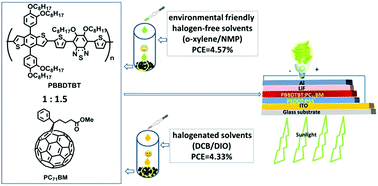Efficient polymer solar cells processed by environmentally friendly halogen-free solvents†
Abstract
The use of environmentally friendly halogen-free organic solvents for the fabrication of polymer solar cells will be of great importance for future practical applications. In this work, a new alternative conjugated polymer with 3,4-bis(octyloxy)-phenyl substituted benzo[1,2-b:4,5-b]dithiophene as the donor unit and benzo[c][1,2,5]thiadiazole as the acceptor unit was synthesized and used as the donor material for polymer solar cells. This polymer showed good solubility in halogen-free solvents such as toluene, o-xylene and so on. The blend film morphology, charge mobility and photovoltaic performance were investigated in halogen-free solvents. The photovoltaic devices fabricated from o-xylene with N-methyl-2-pyrrolidone as additive provided the best power conversion efficiency of 4.57%, comparable to that fabricated from halogenated solvents such as 1,2-dichlorobenzene/1,8-diiodooctane with a power conversion efficiency of 4.33%. Our results demonstrate that halogen-free solvents are promising for the fabrication of high efficiency polymer solar cells.


 Please wait while we load your content...
Please wait while we load your content...